Chiusi › Chocolate › Buddhist Illuminated Scripts of Ancient Korea » Origins and History
Articles and Definitions › Contents
- Chiusi › Origins
- Chocolate › Origins
- Buddhist Illuminated Scripts of Ancient Korea › Origins
Ancient civilizations › Historical places, and their characters
Chiusi › Origins
Definition and Origins

Chiusi ( Etruscan name: Clevsin, Roman : Clusium), located in central Italy, was an important Etruscan town from the 7th to 2nd century BCE. Relations with the Romans famously soured when the king of Chiusi, Lars Porsenna, attacked Rome at the end of the 6th century BCE and contributed to the ending of Rome's monarchy. Nevertheless, despite the Republic's growing stature, Chiusi prospered well into the Hellenistic period. The town's many stone tombs have revealed vibrant wallpaintings, fine Etruscan artworks, large terracotta sarcophagi, and the world-famous Greek black-figure krater, the Francois Vase.
EARLY SETTLEMENT
Located in central Italy just west of Lake Trasimene, Chiusi was a Villanovan settlement (1000-750 BCE), the culture which was a precursor to the Etruscans. Early tombs at the site contained large terracotta vessels inside which were placed 'Canopic' jars containing the cremated remains of the deceased. The jars, typically half a metre in height, are made to resemble human figures, sometimes with a bronze mask attached, dressed in clothing, belts, and jewellery, and seated on miniature thrones of stone, bronze, or terracotta. The jars illustrate Chiusi's, and Etruria 's in general, adoption of art and cultural practices from the Eastern Mediterranean, although Chiusi's preference for cremation of its dead lasted longer than in other Etruscan towns. From the 7th century BCE, the dead were interred in rock-cut tombs often consisting of one main chamber and several smaller side rooms. Some of the earlier stone tombs also contain 'Canopic' jars illustrating a gradual change in burial practices. Some of the tombs have interior wall paintings depicting scenes from Greek and Etruscan mythology.
CHIUSI BENEFITTED FROM FERTILE AGRICULTURAL LANDS, FORESTS & ITS LOCATION ON INLAND ROUTES CONNECTING VARIOUS OTHER ETRUSCAN TOWNS.
A THRIVING ETRUSCAN TOWN
Chiusi was a member of the Etruscan League, a loose confederacy of 12 (or perhaps 15) Etruscan towns (or peoples). They included Cerveteri (Cisra), Populonia (Puplona), Tarquinia (Tarchuna), and Vulci (Velch). Very little is known of this league except that its members had common religious ties and that leaders met annually at the Fanum Voltumnae sanctuary near Orvieto (exact location as yet unknown).
Chiusi benefitted from fertile agricultural lands to produce cereals, forests for timber, and its location on inland routes connecting various other Etruscan towns. These routes followed natural valleys and rivers such as the Tiber and Arno, making Chiusi an important point of connection between northern and southern Etruria. Indeed, Chiusi's trade tentacles stretched much further, as finds of bronze vessels from the town found at Celtic sites in Switzerland and Germany attest. From inscriptions, which the town is particularly rich in, it also seems that citizens of Chiusi participated in the general expansion northwards of the Etruscan cities, establishing colonies in the Po Valley, still then relatively uninhabited.
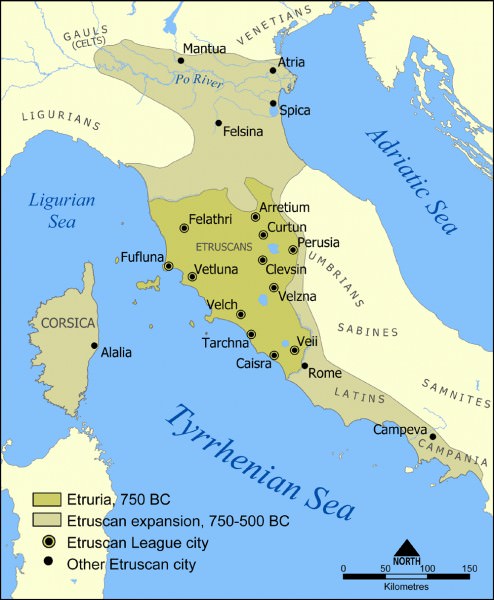
Etruscan Civilization
Chiusi had its own manufacturing workshops and was noted for its bronze work (especially cauldrons and candelabras) and stone-carving. The latter used the local fine limestone known as pietra fetida and was carved, in particular, for funerary containers, sarcophagi, stelae, and tomb markers. These objects were carved with decorative relief scenes of daily life, episodes from mythology, and such guardian creatures as sphinxes and winged lions. The stone was then painted in bright colours, largely now lost on surviving examples. Another type of production was bucchero wares, the glossy almost black pottery made by the Etruscans.
RELATIONS WITH ROME
A famous figure from Chiusi is Lars Porsenna, the king who, according to tradition, laid siege to Rome c. 508 BCE. According to Roman sources, he wanted to put Tarquinius Superbus back on the throne, who was, like many of the city 's early kings, of Etruscan origin. Porsenna finally withdrew after being impressed with his enemy's fortitude and moved off to attack the Latin town of Aricia instead, albeit without success. Another version of the story has Porsenna victorious and Rome surrendering to the Etruscan king, who then, far from reinstalling Superbus, acted to abolish the monarchy of Rome and then attacked Aricia.In the event, Superbus would indeed turn out to be Rome's last king as the Republic set off on its road to greatness. The Roman writer Pliny writes of an impressive monument and tomb to Porsenna which was located outside the city walls of Chiusi and included five huge pyramids, no evidence of which survives today.

Etruscan Cinerary Urn
Chiusi seems to have avoided the general decline that other Etruscan cities suffered, especially the coastal ones following the rise of Syracuse in the 5th-4th century BCE and its takeover of lucrative maritime trade routes. Judging by the tombs and grave goods of the 3rd century BCE, the city was as prosperous as ever, even if an attack by northern Celts had to be resisted. There is evidence that, in the 2nd century BCE, such was Chiusi's wealth, manifested in the landed elite's great demand for funerary art, that artists relocated from declining Etruscan towns like Tarquinia which had failed to meet the challenge of Rome in the 2nd century BCE. Still, Chiusi's turn would eventually come, and by 80 BCE, following the campaigns of Sulla, the town was fully assimilated into the Roman Republic, its residents made Roman citizens, and the Etruscan culture thus faded into the past.
ARCHAEOLOGICAL REMAINS
The tombs of Chiusi have given the world some prize objects. One of these is the celebrated Francois Vase. This large Attic volute-krater, dating to c. 570-565 BCE, is perhaps the example par excellence of the Greek black-figure pottery style with its 270 human and animal figures in scenes from a whole range of myths. Other, less significant finds include bronze incense burners, glass perfume bottles, carved ivory boxes, gold jewellery pieces with granulation and repousse work, and incised gilt- silver vessels.
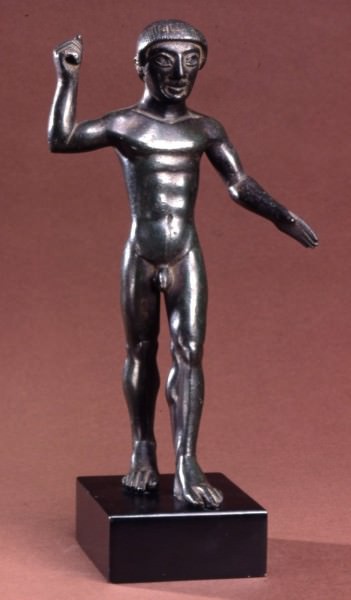
Etruscan Bronze Youth
Tomb Markers & Figures
Several examples of 6th century BCE tomb markers survive, which probably acted as guardians. They once had a round column -drum base and a top carved into a bust of a woman who has her hands clasped together on her chest. Another type of stone funerary statue, and perhaps used as a container for the ashes of the deceased they may have represented, are carved hollow statues of men and women, either standing or seated on a throne. Sarcophagi and stelae show scenes of everyday life and reveal such details as women's clothing (belted long dresses and short cloaks), funeral dances accompanied by musicians (including men and women dressed as satyrs and maenads, respectively), funeral sporting games, weddings, banquets where both men and women are present, and chariot races with details such as spectators, record keepers, and wineskins for the victors.

Etruscan Cinerary Urn
Tomb Wall Paintings
Tombs with wall paintings include the Tomb of the Monkey, constructed 480-470 BCE, which has a scene of a monkey sitting in a tree and another where a woman wearing a red robe is shown seated under a parasol with her feet up on a stool while she watches a parade of jugglers, athletes, dancers, and chariots. Intriguingly, the artist may have used a template for his subjects as not only do some of the scenes closely resemble those in tombs at Tarquinia but also a pair of boxers, who stand facing each other, mirror each other's outlines exactly.
Hellenistic Tombs
Tombs from the Hellenistic period at Chiusi are in two forms. One type is constructed from well-cut blocks and has a barrel vault much like Macedonian tombs. The second type has a much more impressive entrance tunnel; some are up to 25 metres in length. The interiors, conversely, are plainer with a simple rectangular or cross-shaped chamber lined with benches and niches on which were placed funerary jars and sarcophagi. The names of the tomb's occupants are often inscribed on large terracotta tiles which were used to close off the niches. These tombs were used over several generations, and in some cases, the entrance tunnels became the tomb itself with no end chamber. One example has 39 niches and appears to be a forerunner of the later Roman columbaria tombs which housed large numbers of the dead.
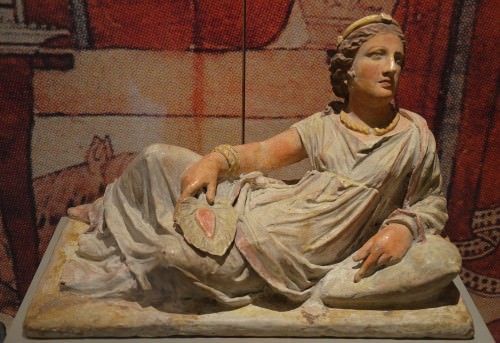
Etruscan Funerary Portrait
Funerary Jars & Urns
Besides the 'Canopic' funerary urns described above, another container of ashes produced in large numbers at Chiusi during the 2nd century BCE was composed of a rectangular base with a single sculpted figure reclining on the lid (a few examples have a couple). Made using molds from terracotta, the bases have relief scenes from mythology (especially battles and perhaps echoing the Etruscan struggle with Rome) while the top figure, presumably an idealised (but not always) representation of the owner of the ashes kept in the urn, is depicted either sleeping or reclining while enjoying a banquet. The urns were brightly painted over a white slip using reds, blues, and yellows. Other, smaller pottery urns from the Hellenistic period have an unusual bell shape and are painted with garlands on a white background.
Chocolate › Origins
Definition and Origins
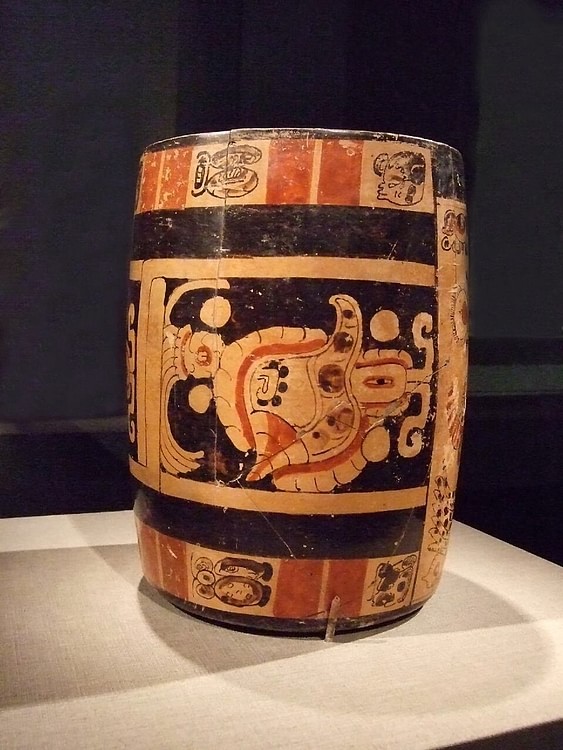
Chocolate was one of the most desired foods of Mesoamerica and was consumed by the Olmec, Maya, and Azteccivilizations, amongst others. Its consumption even spread via trade routes to other parts of the Americas including the Chaco in modern New Mexico. The earliest known use of chocolate was by the Olmec around 1900 BCE and, enjoyed as a drink, it was drunk from special round jars known as tecomates. The Maya used tall cylinder beakers for drinking chocolate, and these very often had text on the rim indicating their intended use. The Aztecs also had richly decorated tall cups specifically reserved for chocolate drinks. It may be that such conspicuous vessels were designed to impress onlookers that the drinker had the means and status to enjoy such a prized drink.
Chocolate is made from the beans of cacao pods from the Theobroma cacao tree (actually native to South America) which was first cultivated in extensive orchards near the Pacific and Gulf coasts of central America, especially in the Xoconusco region and the valleys of the Sarstoon, Polochic, and Motagua Rivers (modern Guatemala and Belize), where the tree thrives in the warm and humid climate. There were, in fact, four varieties of cacao bean or cacahuatl, as the Aztecs knew them, and the corruption of this word or their term for the chocolate drink - xocolatl - is probably the origin of the word chocolate.
So esteemed was chocolate that beans were a commonly traded item, very often demanded as tribute from subject tribes and even used as a form of currency by the Aztecs. In fact, cacao beans were so valuable that they were even counterfeited either to pass as currency or, even more fiendishly, hollowed out of their valuable interior and re-filled with a substitute such as sand.As a currency, we know that in the Aztec markets one cacao bean could buy you a single tomato, 30 beans got you a rabbit and, for the more ambitious shopper, a turkey could be had for 200 beans.
'...THE DRINK OF NOBLES, OF RULERS - FINELY GROUND, SOFT, FOAMY, REDDISH, BITTER.' SAHAGÚN
As an expensive import then, chocolate was drunk mainly by the upper classes and consumed after meals, typically accompanied by the smoking of tobacco. It may have been enjoyed mixed with maize gruel by the poorer classes at important events such as weddings, but some scholars maintain that the pure chocolate drink was an exclusive status symbol of the nobility. Curiously, it could even be given to favoured sacrificial victims as a final treat before they departed this world, for example, at the annual Aztec festival of Panquetzaliztli held in honour of Huitzilopochtli.
To prepare the chocolate, cacao beans were fermented, cured, and roasted. Then the beans were ground into powder and mixed with hot water, as chocolate was usually (but not always) consumed as a warm frothy drink, the froth made by vigorously whisking the liquid with a wooden implement and pouring the liquid from one vessel to another. Indeed, the froth was considered the best part of the drink. Bitter to taste, it could be flavoured by adding, for example, maize, vanilla, flowers, ground chile peppers, herbs, honey, or fermented agave sap ( octli ). Apart from the taste, another advantage of chocolate is that it also contains caffeine and so can act as a stimulant.
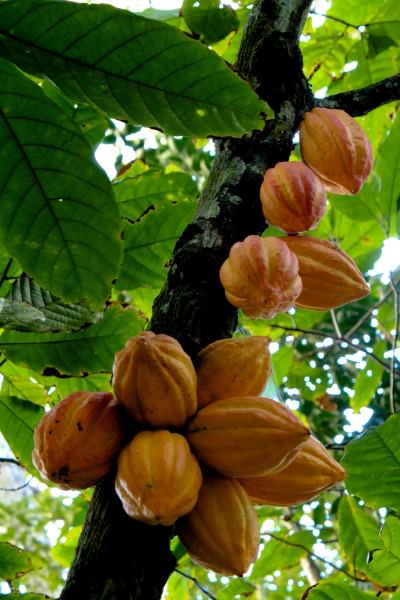
CocoaTree
Bernardino de Sahagún wrote a vivid eye-witness account of how chocolate was prepared by the Aztecs and how to tell a good quality drink from an inferior one:
The seller of fine chocolate [is] one who grinds, who provides people with drink, with repasts. She grinds cacao [beans]; she crushes, breaks, pulverizes them. She chooses, selects, separates them. She drenches, soaks, steeps them. She adds water sparingly, conservatively; aerates it, filters it, strains it, pours it back and forth, aerates it; she makes it form a head, makes it foam; she removes the head, makes it form a head, makes it foam...She sells good, superior, potable [chocolate]: the privilege, the drink of nobles, of rulers - finely ground, soft, foamy, reddish, bitter; [with] chile water, with flowers, with uei nacaztli, with teonacaztli, with vanilla, with mecaxochitl, with wild bee honey, with powdered aromatic flowers. [Inferior chocolate has] maize flour and water;lime water; [it is] pale; the [froth] bubbles burst. (Townsend, 178)
Buddhist Illuminated Scripts of Ancient Korea › Origins
Ancient Civilizations
The Goryeo (Koryo) kingdom ruled ancient Korea from 918 CE to 1392 CE, and it oversaw a flourishing of the arts, literature, and architecture. One of these developments was the production of finely crafted illuminated Buddhist texts. Painted laboriously by Buddhist monks, they spread the sacred texts of Buddhism and their production aided the monk's meditation and progression towards enlightenment.
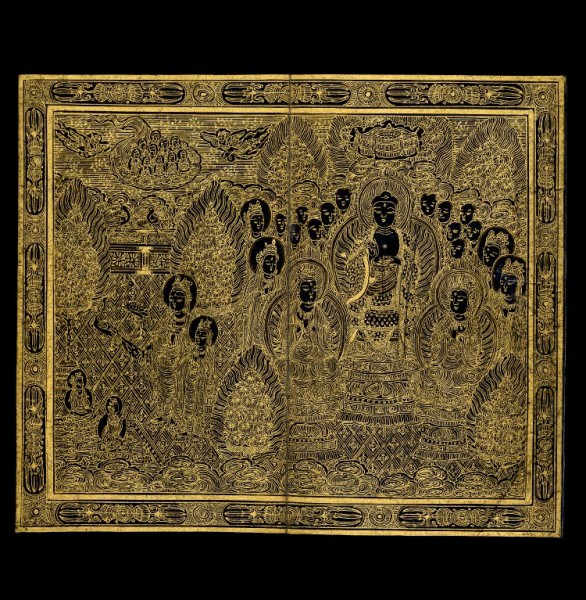
Amitabha Sutra Frontispiece
Buddhism made significant contributions to the arts in ancient Korea from sculpture to poetry, but one of the most time-consuming and meritorious was the hand-copying of sutras or sermons attributed to the Buddha. The two most popular choices of sutra were the Hwaomgyong or Avatamsaka sutra and the Pophwagyong or Lotus sutra. Such was the popularity of these scripts that a Royal Sutra Scriptorium ( Sagyongwon ) was established to meet demand in the 12th century CE. Here not only monks but professional calligraphers worked to produce these popular religious texts. Production was still going strong in the early 14th century CE when king Chungnyol (r. 1274-1308 CE) split the workload into two branches: the Kumjawon and Unjawon, Scriptoriums of Gold and Silver Letters, respectively.
BRIGHT DYES WERE USED & OFTEN EVEN SILVER & GOLD, ESPECIALLY ON THE SPECTACULAR FRONTISPIECE, WHERE THERE WAS A LARGE PANORAMIC IMAGE.
These illuminated manuscripts or sagyong formed scrolls and folded books. The art form was also present in China and Japan, but those produced in the Goryeo dynasty are particularly intricate and splendid such was the level of state endorsement of Buddhism. The scripts were written by monk-scribes expert in calligraphy, who gained great merit for their work in helping the spread of Buddha's teachings, as did the person who commissioned it. Both could expect a more promising future life because of their spiritual endeavour. They were written on hanji, the especially fine paper produced from the inner bark of the mulberry tree, which was considered the highest quality paper in Asia. The paper was usually dyed a deep indigo, but sometimes white or pale yellow hanji was used.
The text was written in Chinese characters ( haeso ), with 15-17 characters on each vertical line. Bright dyes were used and often even silver and gold, especially on the spectacular frontispiece, where there was a large panoramic image, typically of Buddha preaching alongside his followers in paradise. The scene is picked out in gold set along fine iron wiring and bordered by Buddhist symbols such as the cakra wheel (symbol of Buddhist Law) and the vajra thunderbolt (symbol of the power of Buddha's words).
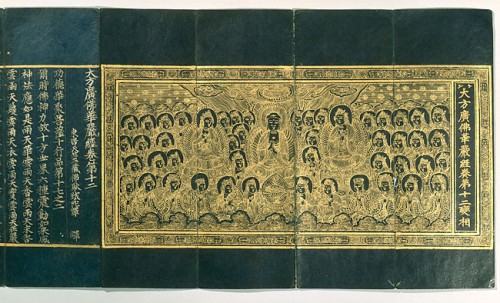
Avatamsaka Sutra Frontispiece
The front and back covers were decorated with posang tangcho, large flowers known as 'precious visages.' The title of the text was written within a rectangular box down one edge of the front cover, usually written in gold lettering. As Buddha's words were contained within, the title was enclosed in a mantra corresponding to the siddham seed character om, meaning the 'lion's roar', ie: Buddha's own voice. The first page of the book indicated who had originally translated the Sanskrit or Pali text, and there is sometimes a royal inscription too. The last page indicates the date of writing and who commissioned the text and why. The motivation for composition ranged from such lofty and desperate aims as saving Korea from invasion to personal salvation, well-being, or even just to make money. Only rarely was the name of the monk who actually created the text noted.
Many illuminated sutras were carefully stored in specially-made boxes of decorated wood or bronze, and some were even placed in tombs or buried at the foot or within stone pagodas at temple sites. One example of the latter is the stone pagoda at Kuhwangni, Gyeongju, built in 692 CE by the Silla king Hyoso. An illuminated sutra was placed within the pagoda in 706 CE by King Seongdeok in memory of his predecessor and the Queen mother Sinmok.
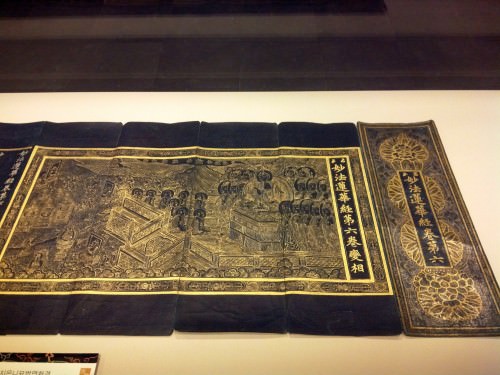
Buddhist Illuminated Manuscript, Goryeo Period
A great many of the Goryeo illuminated scripts ended up abroad, for they were highly prized by the Chinese, Japanese, and Mongols. When the kingdom was obliged to pay tribute to China, illuminated scripts were often a part of it. The monks themselves were sometimes sent to work abroad too, as one passage in the 15th-century CE official Goryeo history Goryeosa( Koryo sa ) indicates:
In March of the 16th year of King Chungnyol (1290), the Chinese emperor ordered the writing of gold and silver sutras, and selected excellent monk scribes, therefore 35 Korean monks were dispatched to the Yuan court...In April of the same year, 65 Koryo monks, sutra-writers, were dispatched to Yuan... (Portal, 88)
In Japan many illuminated sutras were kept in their own Buddhist temples, indeed the oldest surviving example, dating to 1006 CE, resides in the Bunkacho in Tokyo. Besides those remaining in Korea, the British Museum in London has a particularly fine example of the Amitabha sutra. The frontispiece shows a panoramic scene where Buddha and bodhisattvas welcome new souls to paradise. It is painted in silver and gold and dates to 1341 CE, as indicated on its inscription. The text also notes that it was written by a monk called Chonggo for his mother.
This article was made possible with generous support from the British Korean Society.
LICENSE
Article based on information obtained from these sources:with permission from the Website Ancient History Encyclopedia
Content is available under License Creative Commons: Attribution-NonCommercial-ShareAlike 3.0 Unported. CC-BY-NC-SA License